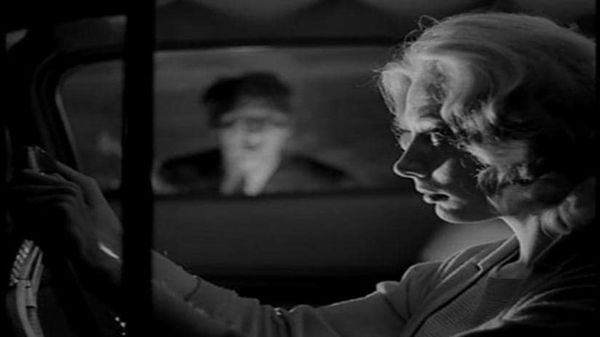Eye For Film >> Movies >> Carnival Of Souls (1962) Film Review

Carnival Of Souls may open with that most conventional of scenes from the movies of the Fifties/Sixties, a drag race, but there is something not quite right, something jarring, in the way that the sequence draws the viewer right into the middle of the action. At a set of traffic lights, a male driver challenges three women in an adjacent car to race, and they're off - without preamble, set-up, characterisation, or even the mild comfort of a production logo.
So unsettling is the documentary immediacy of it all that for a second or two one might even imagine that the film has begun with the wrong reel. Then the women's car plummets off a railroad bridge, sinking into the waters below, and the credits roll, confirming this is indeed the film's beginning – even if the title sequence itself seems just as discomfiting, with credits placed at skew-whiff angles over images of the river, all to the accompaniment of eerie, off-key organ modulations.

This mood of disorientation dominates Carnival Of Souls. If its protagonist, an earnest young woman named Mary Henry (Candace Hilligoss), herself feels out of sorts and increasingly detached from her environs and "the close company of other people", her sense of alienation is shared by the viewer, thanks to unusual camera angles, an unnervingly designed soundtrack, and some oddly stilted performances. The latter might in part result from director Herk Harvey's use, necessitated by a minuscule budget, of an unknown and largely unprofessional cast, but he makes this work very much in the film's favour. Here, everything may feel just slightly wrong, but that is an effect that will turn out to be just right.
Our heroine emerges from the river's waters, pale and traumatised, but miraculously clinging to life. After all, she is, as she will later put it, "a person of strong will". Still, there is something about Mary. Remote, hesitant, cold both sexually and spiritually, she keeps everyone at a distance – and when she drives, two days after the accident, to Utah to take up a new job as a church organist, her life begins to unravel.
There, she starts seeing dead people, she is haunted by a zombie-like man (played by Harvey himself), and she finds herself mysteriously drawn to an abandoned amusement park (and former bathhouse) on the saltlake marshes where lost souls come out to play. It is just as well that her bath-obsessed landlady (Frances Feist) and lecherous rooming-house neighbour (Sidney Berger) are both so keen for Mary to stay, as she may well find it very hard to leave.
Made for peanuts (and completely outside the studio system) by a Kansas-based director and screenwriter team whose only other credits are for industrial and public information films, Carnival Of Souls effectively disappeared without trace after its initial drive-in run, only to be rediscovered and re-released in the late 1980s in a slightly longer version – and it has been a cult classic, as well as a staple of late-night American television, ever since.
From the moment the railroad bridge has appeared in the prologue, anyone versed in the short stories of Ambrose Bierce will have an idea where this story is headed – and the 'surprise' of the ending has also been somewhat blunted by its own influence on a whole host of subsequent films (that it would be criminal to name here). Fortunately, however, Carnival Of Souls is in no way reducible to its twist – for as Mary goes on her strange journey, be it on a bridge between here and there or in the liminal wetlands between populated land and receded lake, she is also travelling through the shifting frontiers of her own times.
A frigid woman surrounded by oversexed men, a church worker without any faith of her own, an independent working girl estranged from her own family, this fish out of water reflects the anxieties of an increasingly secularised, liberated, educated American youth – and the traditional authorities embodied by a minister (Art Ellison), doctor (Stan Levitt) and sheriff (Wayne Shmille) will be left simply bewildered by what becomes of her.
As are we – for while the closing scene does offer a satisfyingly spooky solution to the film's uncanny events, Harvey leaves enough questions unanswered in this twilight zone to ensure that Carnival Of Souls enjoys a haunting afterlife in the viewer's mind. It is chilling precisely because we never quite know where the nightmare begins or ends, so that we too are submerged in the darkest, murkiest undercurrents of the 1960s. And although this film has been remade once (in 1998) and reimagined countless times, it is always worth returning to the source – after all, you cannot step into the same river twice.
Reviewed on: 28 Feb 2009

















